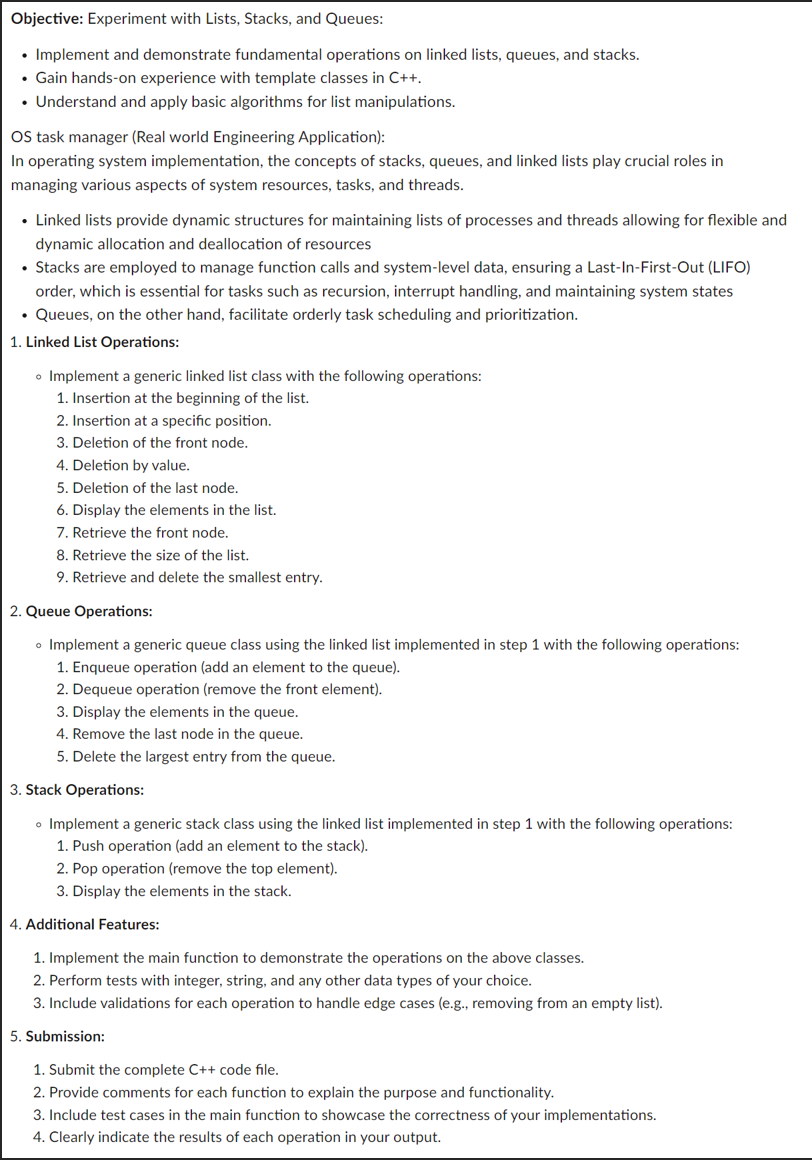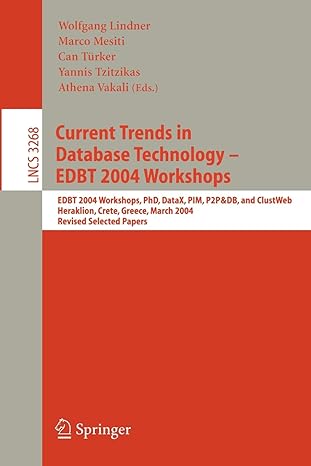Answered step by step
Verified Expert Solution
Question
1 Approved Answer
Objective: Experiment with Lists, Stacks, and Queues: Implement and demonstrate fundamental operations on linked lists, queues, and stacks. Gain hands - on experience with template
Objective: Experiment with Lists, Stacks, and Queues:
Implement and demonstrate fundamental operations on linked lists, queues, and stacks.
Gain handson experience with template classes in C
Understand and apply basic algorithms for list manipulations.
OS task manager Real world Engineering Application:
In operating system implementation, the concepts of stacks, queues, and linked lists play crucial roles in
managing various aspects of system resources, tasks, and threads.
Linked lists provide dynamic structures for maintaining lists of processes and threads allowing for flexible and
dynamic allocation and deallocation of resources
Stacks are employed to manage function calls and systemlevel data, ensuring a LastInFirstOut LIFO
order, which is essential for tasks such as recursion, interrupt handling, and maintaining system states
Queues, on the other hand, facilitate orderly task scheduling and prioritization.
Linked List Operations:
Implement a generic linked list class with the following operations:
Insertion at the beginning of the list.
Insertion at a specific position.
Deletion of the front node.
Deletion by value.
Deletion of the last node.
Display the elements in the list.
Retrieve the front node.
Retrieve the size of the list.
Retrieve and delete the smallest entry.
Queue Operations:
Implement a generic queue class using the linked list implemented in step with the following operations:
Enqueue operation add an element to the queue
Dequeue operation remove the front element
Display the elements in the queue.
Remove the last node in the queue.
Delete the largest entry from the queue.
Stack Operations:
Implement a generic stack class using the linked list implemented in step with the following operations:
Push operation add an element to the stack
Pop operation remove the top element
Display the elements in the stack.
Additional Features:
Implement the main function to demonstrate the operations on the above classes.
Perform tests with integer, string, and any other data types of your choice.
Include validations for each operation to handle edge cases eg removing from an empty list
Submission:
Submit the complete code file.
Provide comments for each function to explain the purpose and functionality.
Include test cases in the main function to showcase the correctness of your implementations.
Clearly indicate the results of each operation in your output.
Provided Code:
#include
#include A
using namespace std;
Node class:
template
class Node
public:
T data;
Node next;
Node previous;
Constructor to initialize the node with a given value
NodeT value
data value;
next nullptr;
previous nullptr;
;
Linked list class:
template
class LinkedList
public:
Default constructor
LinkedList
head nullptr;
Insert at the beginning of the list
void insertT value
Node newNode new Nodevalue;
newNodenext head;
head newNode;
Remove the front node in the list
void removeFront
if head nullptr
Node temp head;
head headnext;
tempnext nullptr; Disconnect the removed node from the list
delete temp;
Remove the last node in the list
void removeEnd
if head nullptr
return;
if headnext nullptr
delete head;
head nullptr;
return;
Node current head;
while currentnextnext nullptr
current currentnext;
delete currentnext;
currentnext nullptr;
Display the elements in the list
void display
Node current head;
while current nullptr
cout currentdata ;
current currentnext;
cout endl;
Get the front node
Node getFront
return head;
private:
Node head;
;
Queue class using linked list
template
class Queue
public:
Enqueue operation
void enqueueT value
list.insertvalue;
Dequeue operation
void dequeue
list.removeEnd;
Display the elements in the queue
void display
list.display;
Remove the last node in the queue: FIFO
void removeEnd
list.removeEnd;
private:
LinkedList list;
;
Stack class using linked list
template

Step by Step Solution
There are 3 Steps involved in it
Step: 1

Get Instant Access to Expert-Tailored Solutions
See step-by-step solutions with expert insights and AI powered tools for academic success
Step: 2

Step: 3

Ace Your Homework with AI
Get the answers you need in no time with our AI-driven, step-by-step assistance
Get Started


